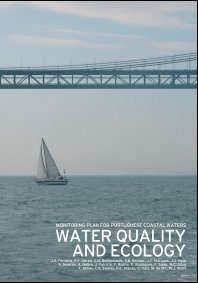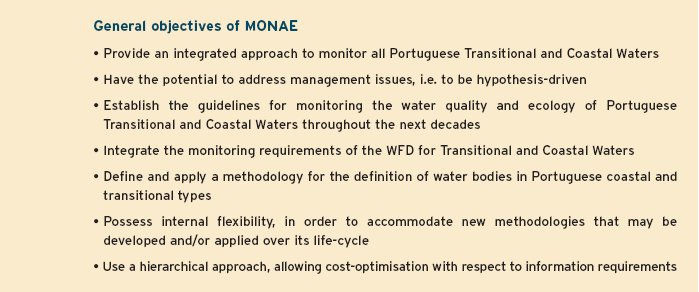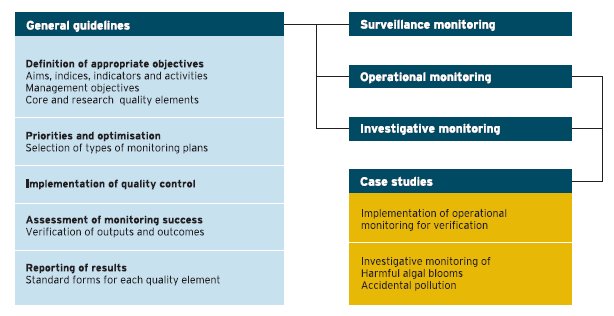
How do I get a copy of this book?
Send an email here with your postal address and MONAE in the subject.
Introduction
Portugal has a number of important estuaries, which fall under the category of transitional waters – two of these, and parts of the rivers which flow into them, form the northwestern and southeastern borders with Spain. Portugal has an extensive coastal area, which delimits the country to the west and to the south.
The project “Monitoring Plan for Water Quality and Ecology of Portuguese Transitional and Coastal Waters”, or MONAE, was financed by the Portuguese Water Institute, INAG, and carried out by an interdisciplinary team drawn from marine science and management experts in the E.U., U.S. and South Africa. It started on February 9th 2004, and had a duration of one year. This project aims to provide the reader with a blueprint for the development of a successful and economically viable monitoring plan, based on soundly formulated hypotheses and containing appropriate verification instruments. Data were drawn from many sources, including the databases built during the coastal typology and reference conditions project TICOR.

The E.U. Water Framework Directive (WFD – Directive 2000/60/EC) outlines the requirements for monitoring of surface waters in the European Union, within the general framework of river basin management plans. Three distinct types of monitoring are stipulated, in order to meet the overall goal of assessing the quality status of European waters. The focus of this book is only on transitional (estuarine) and coastal waters, for which the following monitoring types and objectives are defined in the WFD.

Key outputs and findings
A summary of the key outputs and findings of MONAE are presented below.
Data Overview
Data collection in Portuguese Transitional and Coastal Waters has been carried out regularly in several thematic areas, including hydromorphology, marine geology, water quality, phytoplankton, shellfish and specific pollutants.
Most of the data collected by institutions in Portugal are stored in internal databases. The
availability of historical data is thus compromised by data fragmentation, which
stems from the lack of coordination of monitoring activities both at
a system (e.g. estuary or lagoon) and at national level.
The figure below summarises the currently available historical datasets as well as other less accessible data. There is a large quantity of data for Portuguese Transitional and Coastal Waters. However the datasets are concentrated both in time and space, which means that in most cases they are not representative of a comprehensive system survey, due to the nature of the sampling design. In several systems the number of sampling stations, although high, covers only part of the system. This issue must be addressed when designing future monitoring plans, since there is a need to choose representative sampling stations in accordance with the water bodies defined for an effective implementation of the WFD.

Spatial Domain
An approach for the division of Transitional and Coastal Waters in Portugal into water bodies for management and monitoring purposes was developed in MONAE. Two distinct methodologies were used: for the definition of Open Coastal Water Bodies literature results were used, and for Transitional and Restricted Coastal Water Bodies, a bottom-up data analysis approach was carried out.

There are common points to both methodologies, since in both cases natural factors such as salinity or morphology are combined with the human
dimension, using the significant pressures and/or key elements of state. The application of these methodologies has resulted in the
proposed definition of 60 transitional and coastal water bodies for Portugal.
Monitoring Plans
Definitions and guidelines
Although the general objective of monitoring specified in the WFD is to verify compliance with water quality
objectives, or to establish the reasons for non-compliance so that appropriate measures may be put in place where applicable, a monitoring plan should examine these questions in broader terms, from the standpoint of ecosystem health.
Monitoring activities that address a broad set of aims use indicators as proxies for these. In the WFD, these
indicators must include the appropriate Biological Quality Elements (BQE) and Supporting Quality Elements (SQE), and may include others. Indicators may have
different levels of aggregation, ranging from, for example, combined indices of eutrophication or benthic quality status to the concentration of a particular parameter such as dissolved oxygen, and may be defined collectively as Environmental Quality Proxies (EQP). In the WFD these correspond to different combinations of BQE and SQE.
Relevant objectives should be defined for management of Transitional and Coastal Waters, forming a set of goals, which may need to be harmonised in time, space, and within the allowable EQP thresholds. Three broad groups of management objectives may be defined:
Water quality objectives – e.g. (i) Restore and maintain a productive ecosystem with no adverse effects due to pollution; (ii) Minimize health risks associated with contact water uses; (iii) Estimate adverse impacts of eutrophication, including hypoxia resulting from human
activities;
Conservation objectives – e.g. (i) Maintain on a landscape level the natural environment of the watershed; (ii) Protect existing habitat categories within the watershed to preserve and improve regional biodiversity;
Human use objectives – e.g. (i) Support water-related recreation whilst preserving the economic viability of commercial endeavours; (ii) Encourage sustainable lifestyles within the watershed, whereby human uses are balanced with ecosystem protection; (iii) Empower citizens in the protection and stewardship of the estuary and its watershed.

A number of monitoring plans for coastal systems in the E.U. and U.S. have identified several types of indicators that can be used,
which may be applied in a complementary manner to address the issues under consideration. These are typically divided into core and research indicators, and are evaluated in distinct types of monitoring plans. This fits in well with the concepts outlined in the WFD and developed in various guidance documents, i.e. that for surveillance monitoring the full spectrum of BQE/SQE needs to be covered, for operational monitoring the indicators need to be far more targeted, and in the case of investigative monitoring the focus is on the detailed understanding of a specific issue.
Assessment of monitoring success
Each monitoring plan must set out a number of objectives, which may be grouped into two different types: the first focuses on the outputs,
and is effectively an internal audit - verification would include compliance with the various terms of reference for time, space, parameters,
methodology, etc. The second type examines the success in terms of outcomes, i.e. it is the component that informs management
action.
Programme implementation
(outputs) - These are verifiable targets which may be related to the MONAE terms of reference, i.e. Are the goals and objectives of the plan being met. This answers programmatic questions such as: (a) Is the sampling covering the estuaries/coastal systems specified in the plan? (b) Is the strategy defined for a particular system (e.g. sampling according to a salinity gradient, particular vertical profiles or seasonality being followed? (c) Are the parameters being measured as required by the WFD? (d) Are methodology issues (intercalibration of methods, etc.) being handled as recommended?
Programme effectiveness, i.e. environmental success
(outcomes)
-A distinct set of targets, based around specific ecological quality achievements, must answer questions such as: (a) Are shellfish/finfish areas increasing/decreasing? (b) Are salt marsh areas increasing/decreasing? (c) How is the frequency/spatial scope of elevated chlorophyll a
evolving? (d) What are the observable trends for HAB events? (e) Are elevated nutrients correlated with elevated chlorophyll a? These questions should be centered around the BQE/SQE, and the indices into which these are aggregated.
Surveillance monitoring
Appropriate frequencies for sampling biological quality elements and supporting quality elements are proposed for open coastal waters, inshore coastal waters and transitional waters. Guidelines are also provided for
vertical resolution of water column sampling. The definition of water bodies shown in Figure 3 will result in a tentative network of 60-120 stations for all of Portugal, considering 1-2 stations per water body as an indicator of spatial resolution. Modifications to the number of water bodies will result in potential changes to the station network, both in number and distribution.
Operational monitoring
Two key objectives are indicated in the WFD for operational monitoring. The first objective ( screening) of operational monitoring is concerned with further investigation into a water body which is at risk of non-compliance with environmental objectives, i.e. which appears from surveillance monitoring data to be at moderate, poor or bad status for
one or more quality elements. This is interpreted in MONAE to be applicable mainly for water bodies diagnosed as being at moderate status, where more detailed studies will help establish the status of the water body. The second objective ( verification) is to verify post-facto if management measures are working, i.e. from a Pressure-State-Response perspective, if a reduction in pressure due to management response has resulted in the expected change in state.
Investigative monitoring
 |
This type of monitoring is research-oriented, and aims (i) to clarify unknown or poorly
understood pressure-state relationships in order to inform an appropriate response; or (ii) to investigate accidental pollution events such as oil spills, and provide a blueprint for
management measures, including mitigation and actions for future prevention. Investigative monitoring of the marine environment is by nature interdisciplinary – the problems addressed are diverse, and constrained by different levels of understanding. Issues range e.g. from the interpretation of the effects of an accidental oil spill, where most processes are well understood, to the understanding of changes in biodiversity, affecting e.g. phytoplankton or benthic species composition, which are rather poorly understood. |
Economic Analysis
The general definitions of different cost concepts are reviewed, and an estimate of existing monitoring costs from systems in different countries is then used to estimate a unit cost for monitoring, based on a station-sample pair - this is defined as a sample taken at a station on one occasion, which may include only one depth or multiple depths. The entity corresponds to a sampling visit to a particular geographic location. The information used to compile unit costs was drawn from work carried out in Portugal, the United States and China, within the framework of monitoring activities and research projects. The data were then normalised to Purchasing Power Parity (PPP€).

This approach allowed a comparison among different countries, both in terms of overall costs and the relative proportions of cost components. These data were then used to extrapolate costs for all three types of monitoring under the WFD, and are summarised above.
Public Participation
Public participation is an integral part of the application of the WFD. An overview of concepts and scope is carried out, followed by an analysis of specific issues associated to public participation in Portugal. Two modes of collaborative monitoring merit a comment. The first is the co-operation
between environmental Non-Governmental Organisations and schools. The second is the use of low-cost sensors, which dramatically improves the ability of a volunteer to gather scientifically valid data.
Both have the potential to generate a huge amount of relevant, cost-effective information. Public intervention may also be important for emergency alert purposes, such as oil spills or dead dolphins, although in this case there must be a competent authority with permanent real-time response capacity. Finally, the specificity of public participation in coastal management is examined in detail, and a methodology is proposed for the design and implementation of an information system designed to deal with the two-way information flow between the management community and the public at large.
MONAE Products
MONAE is described in a book, which may be requested free of charge by sending an email to mena@megamar.org with your request, together with your name and address. An electronic copy is also available in pdf here.
The book is aimed at a broad audience. Scientific papers supporting the work described in this book appear below:
J. G. Ferreira, A. M. Nobre, T. C. Simas, M. C. Silva, A. Newton, S. B. Bricker, W. J. Wolff, P.E. Stacey, A. Sequeira, 2005. A methodology for defining homogeneous water bodies in estuaries – Application to the transitional systems of the EU Water Framework Directive. Estuarine, Coastal and Shelf Science, 66 (3/4), 468-482.
J. G. Ferreira, C. Vale, C.V. Soares, F.Salas, P.E. Stacey, S. B. Bricker, M.C. Silva, J.C. Marques, 2007. Monitoring of coastal and transitional waters under the EU Water Framework Directive. Environmental Monitoring and Assessment, Accepted.
MONAE Project team
|
Name |
|
| Alexandre Bettencourt (consultant) | abettencourt@mail.telepac.pt |
| Suzanne Bricker (consultant) | Suzanne.Bricker@noaa.gov |
| João Gomes Ferreira (project coordinator) | joao@hoomi.com |
| Fuensanta Salas Herrera | fuenmar@um.es |
| João Carlos Marques | jcmimar@ci.uc.pt |
| João Joanaz de Melo | jjm@fct.unl.pt |
| Alice Newton | anewton@ualg.pt |
| Ana Nobre | ana@salum.net |
| Joana Patrício | jpatricio@ci.uc.pt |
| Fernanda Rocha (INAG) | frocha@inag.pt |
| Rui Rodrigues (INAG coordinator) | rrr@inag.pt |
| Margarida Cardoso da Silva | MCSilva@lnec.pt |
| Teresa Simas | teresa@ecowin.org |
| Carlos Ventura Soares | ocean.vs@clix.pt |
| Paul Stacey (consultant) | rifisher@myway.com |
| Carlos Vale | cvale@ipimar.pt |
| Martin de Wit | mdewit@csir.co.za |
| Wim Wolff (consultant) | W.J.Wolff@rug.nl |
Document retrieval area
The documents in this section may be downloaded, and include general WFD materials, guidance documents, and the MONAE book.
Document list for MONAE in reverse chronological order - Click to open or right-click to download
| File name | Type | Date |
| Danish Eutro report 2003 | Adobe Acrobat Document | 15 of December 2014 |
| Barnegat Bay Monintoring plan | Adobe Acrobat Document | 15 of December 2014 |
| borja DPSIR WFD ECSS | Adobe Acrobat Document | 15 of December 2014 |
| Borja marine pollution bulletin | Adobe Acrobat Document | 15 of December 2014 |
| CoastalClassification Final | Adobe Acrobat Document | 15 of December 2014 |
| Ecological Classification Guidance | Adobe Acrobat Document | 15 of December 2014 |
| ECSS MSD687 | Adobe Acrobat Document | 15 of December 2014 |
| EU_US_Sci-Init | Adobe Acrobat Document | 15 of December 2014 |
| Fish tissue & Sediment monit (Virginia) | Adobe Acrobat Document | 15 of December 2014 |
| g5-final quality assurance | Adobe Acrobat Document | 15 of December 2014 |
| g5m-final quality assurance for modelling | Adobe Acrobat Document | 15 of December 2014 |
| hab noaa | Adobe Acrobat Document | 15 of December 2014 |
| MONAE book | Adobe Acrobat Document | 15 of December 2014 |
| HAB_Mexico | Adobe Acrobat Document | 15 of December 2014 |
| habitats 92-43 | Adobe Acrobat Document | 15 of December 2014 |
| MCS_Estuarine indicators | Adobe Acrobat Document | 15 of December 2014 |
| Monitoring EPA | Adobe Acrobat Document | 15 of December 2014 |
| New Hampshire Monitoring pllan | Adobe Acrobat Document | 15 of December 2014 |
| Monitoring Northern Ireland | Adobe Acrobat Document | 15 of December 2014 |
| Oil monitoring | Adobe Acrobat Document | 15 of December 2014 |
| San Francisco bay | Adobe Acrobat Document | 15 of December 2014 |
| Tillamook Bay monitoring plan | Adobe Acrobat Document | 15 of December 2014 |
| Seaward limit New Zealand | Adobe Acrobat Document | 15 of December 2014 |
| UK monitoring AE12NMMP | Adobe Acrobat Document | 15 of December 2014 |
| UK monitoring GBMain Text 1103 | Adobe Acrobat Document | 15 of December 2014 |
| UK monitoring nmmp2 | Adobe Acrobat Document | 15 of December 2014 |
| UK monitoring mpmmg5 | Adobe Acrobat Document | 15 of December 2014 |
| Water Framework Directive | Adobe Acrobat Document | 15 of December 2014 |
| WFD guidance on monitoring | Adobe Acrobat Document | 15 of December 2014 |
| WFD CIS2.4 (COAST) Guidance on TCW | Adobe Acrobat Document | 15 of December 2014 |
Links
NOAA NCCOS - National Centers for Coastal Ocean Science
PERFECT - Literature database for Portuguese estuaries
ASSETS - Estuarine eutrophication assessment
Site developed by: IMAR-GEM - Institute for Marine Research - 2004-2006